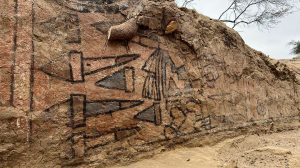In November 2022, in a village in Lambayeque in northern Peru, Swiss archaeologist Sâm Ghavami, helped by Peruvian students, discovered a pre-Hispanic fresco. Surprisingly, the wall painting was already known by the archaeological community since it was first visible on a series of black and white photographs (Figure 1) taken by German ethnologist Hans Heinrich Brüning in 1916 (Schaedel 1978 and Farrant 2022). However, these pictures, only rediscovered in 1976, did not get the archaeologists’ attention because they believed that the site had already been destroyed (Whiddington 2022)… until Ghavami decided to excavate it after reading an article containing the black and white pictures.
The mural is part of the Huaca Pintada temple, which was built by the Moche civilization that flourished between the 1st and 8th centuries. It depicts mythological scenes, in particular a bird-like god with Moche warriors, and may represent the Moche “worldview”, organized around veneration of the ancestors, of nature, and of the Moon (Whiddington 2022). In fact, the Moon goddess was the most powerful deity for the Moche since she could appear at night and during the day, and thus was seen as even more powerful than the Sun (Dreffs 2020).
Moreover, as Sâm Ghavami said: “It’s an exceptional discovery because it is rare to unearth wall paintings of such quality in pre-Colombian archeology” (Farrant 2022). In fact, the mural is exceptionally well-preserved: the blue, brown, red, white and yellow paint colors are still visible, even after 1000 years (Figure 2).
This discovery is exciting because it has a deeper meaning. It is indicative of the development of an ancient Peruvian cultural phenomenon (Farrant 2022). In fact, on top of the Moche, we can also see elements of another pre-Incan culture, the Lambayeque (who lived in northern Peru between 900 and 1350 AD). Ghavami aims to further decrypt the message conveyed by the wall as part of his research, and hopes to be able to understand the social, political and cultural changes that affected the region and its societies (Whiddington 2022). As he said, perhaps it “could be interpreted as a metaphorical image of the political and religious order of the region’s ancient inhabitants” (Farrant 2022). This approach echoes the “traditionalist archaeological explanations of change in the past” approach that focuses on the notions of diffusion and migration. This is the idea that “changes in one group must have been caused either by the influence or influx of a neighboring and superior group” (Renfrew 2018). However, it will surely be difficult to try to get information about the relationship between pre-Incan societies (Moche, Lambayeque…) from this mythological painting.
Further Reading:
https://www.worldhistory.org/Moche_Civilization/
References:
1) Farrant, Theo. December 02, 2022. “Archaeology students uncover long-lost pre-Hispanic mural in Peru.” Euronews. https://www.euronews.com/culture/2022/12/02/archaeology-students-uncover-long-lost-pre-hispanic-mural-in-peru
2) Whiddington, Richard. December 02, 2022. “A Pre-Hispanic Mural Depicting Moche Warriors Has Been Rediscovered in Northern Peru After Being Lost for More Than a Century.” Artnet. https://news.artnet.com/art-world/archaeologists-uncover-ceremonial-water-structures-machu-picchu-2053699
3) Dreffs, Melissa. October 26, 2020. “Moche Civilization: Northern Peru’s Ancient Artisans.” Peru for Less. https://www.peruforless.com/blog/moche-civilization/
4) Schaedel, Richard. February 1978. “The Huaca Pintada of Illimo.” Archaeology. https://www.jstor.org/stable/41726855#metadata_info_tab_contents
5) Renfrew, Colin & Bahn, Paul. November 26, 2018. Archaeology Essentials: Theories, Methods, and Practice. Chapter 10:277. Thames & Hudson, 4th edition.




